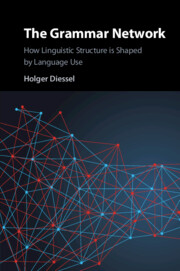Part III - Filler–Slot Relations
Published online by Cambridge University Press: 12 August 2019
Summary
There is an ongoing debate about the analysis of argument structure in a usage-based construction grammar. Some scholars have argued that argument structure is licensed by fully abstract schemas, but other researchers have claimed that argument structure is primarily determined by particular verbs. Chapter 7 argues that this controversy is easily resolved if we analyze argument structure in the framework of a network model in which verbs and constructions are interconnected by probabilistic links. For instance, the two constructions of the dative alternation occur with an overlapping set of verbs that are statistically biased to be used in one or the other constructions. The statistical biases can be analyzed as filler-slot associations that are shaped by two factors: (1) general conceptual processes of event semantics and (2) speakers’ experience with particular verbs and constructions. The analysis is supported by evidence from research on sentence processing and the extension of argument schemas to novel verbs in L1 acquisition and language change.
Keywords
- Type
- Chapter
- Information
- The Grammar NetworkHow Linguistic Structure Is Shaped by Language Use, pp. 113 - 196Publisher: Cambridge University PressPrint publication year: 2019



